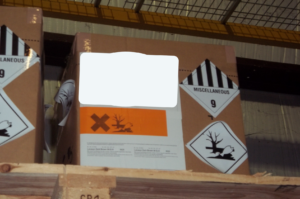(June 26, 2020) A question from a customer of mine:
hi Daniel
I am shipping two boxes of un3077 environmentally hazardous substances, solid., n.o.s. ( dibutyl phthalate), 9, III. This is going ground to Texas. my question is do we have to put the marine pollutant label if its going ground.
I know marine pollutant labels is required for some going ocean. I am also wondering do we have to apply this label if its going air with the class 9.
thanks for your help.
Contact me with any questions you may have about the transportation of hazardous materials by air, highway, vessel, or rail International and Domestic Daniels Training Services, Inc. 815.821.1550 |

My reply that same day:
Thank you for contacting me. Please see below.
- A marine pollutant is classified by USDOT/PHMSA for transportation within the U.S. as follows:
- It must be identified by name in Appendix B of the Hazardous Materials Table at 49 CFR 172.101 (the Marine Pollutant Table).
- The named marine pollutant must be at a concentration in a solution or mixture of 10% or more for a marine pollutant or 1% or more for a severe marine pollutant.
- The substance must be transported in any packaging (bulk or non-bulk) by vessel or in a bulk packaging by highway, rail, or aircraft.
- Your email does not indicate if the two boxes are bulk packaging or non-bulk packaging. Based on my knowledge of your operations I will presume them to be a non-bulk packaging.
- A non-bulk packaging transported by highway within the U.S. can not be a marine pollutant subject to the Hazardous Materials Regulations (HMR) of the USDOT/PHMSA.
- Also, dibutyl phthalate is not identified as a marine pollutant in the Marine Pollutant Table, so that’s strike three right there.
- Unless subject to the HMR as a hazardous material for some other reason, this substance will not be regulated as a hazardous materials when offered for transport by highway within the U.S.
- You are correct that the classification of a marine pollutant subject to the International Maritime Organization Dangerous Goods Code (IMDG Code) differs from that of USDOT/PHMSA. It is quite possible this substance is a marine pollutant subject to the IMDG Code. More information is necessary to make that classification. If a marine pollutant per the IMDG Code and it does not display any other hazards, e.g., flammability, corrosivity, it will be classified as a Class 9 Miscellaneous.
- If to be transported by air, the Dangerous Goods Regulations of the International Air Transport Association (IATA) will apply. IATA classifies a marine pollutant in the same manner as the IMO, therefore, it is quite possible (more information is necessary to be certain) this substance is a marine pollutant – and therefore a Class 9 Miscellaneous as well – when transportation is by air.
I hope this helps. Please contact me with any other questions.
And that did it!
it does help thank you
